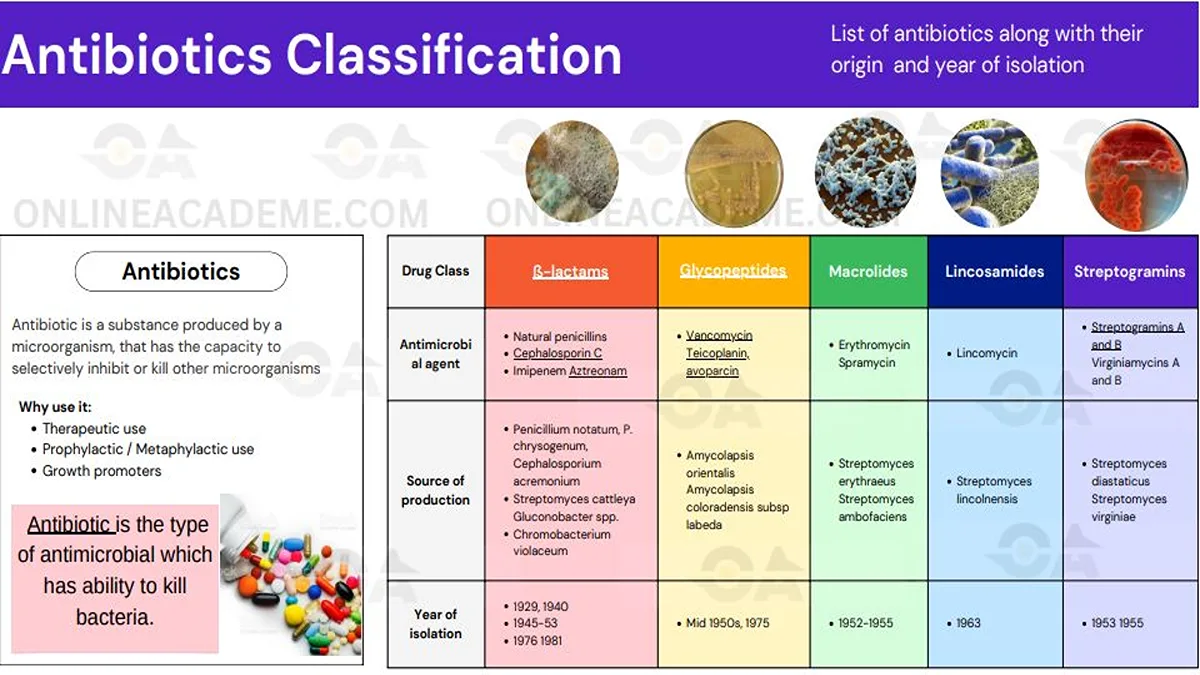What is an antimicrobial/ antibiotic?
Many of people will be familiar with these terms antimicrobial or antibiotic as they may be treated with some antimicrobial or antibiotic when they got sick or developed any bacterial infection. In general terms it is the ability of any substance to kill or inhibit the bacteria but the exact definition and antibiotics list is discussed in detail.
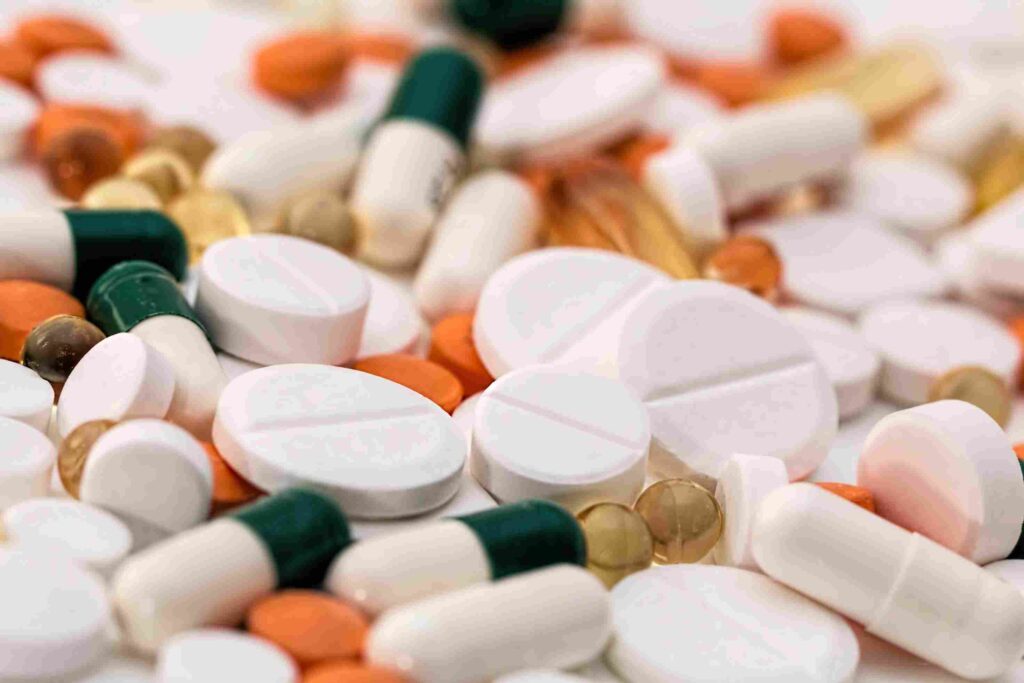
Human history has witnessed various bacterial outbreaks like black death (1346-1353) resulting in millions of deaths. After discovery of bacteria by scientists a lot of antibiotics were discovered to kill them and treated deadly infections for decades but after excessive use of antibiotics over last few decades bacteria are becoming resistant against available antibiotics and as a result of this threatening phenomenon we will be left with fewer treatment options which are getting ineffective day by day.
On the other hand, their lack of new drug discovery. Therefore, antibiotic resistance and lack of antibiotic discovery threatens global effors to reduce antibiotic resistance and emergence of multidrug resistance in deadly bacteria. To develop basic understanding about antibiotics ,discovered so far, here is quick review of available antibiotics list along with their source of production and year of isolation. The detail is as under
Antimicrobial definition:
Antimicrobials are mostly isolated from medicinal plants and fungi however, their are a lot of antibiotics or drugs developed synthetically. Antimicrobial is a broader term referring to any substance that can affect microbial life, including synthetic and semi synthetic compounds and substances without selective toxicity (e.g. biocides). Some of the most toxic substances in the world 0.001-4 mg/L have an effect, but in therapeutic doses they do not harm the host and they have minimum effects on eukaryotic cells.
Antibiotic definition:
Antibiotic is a substance produced by a microorganism, that has the capacity to selectively inhibit or kill other microorganisms (Paul Vuillemin, 1941). Antibiotic is the type of antimicrobial which has ability to kill bacteria.
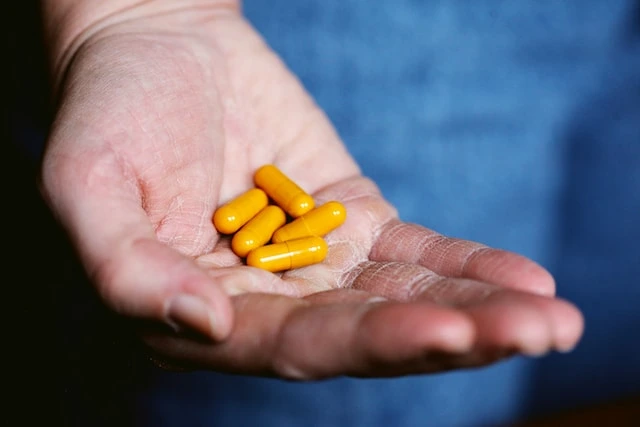
What is the use of antimicrobial/ antibiotic?
Use of antimicrobials in humans
Antimicrobials or antibiotics are (should be) used in humans mainly to kill or inhibit harmful bacteria that cause infection and disease .The CDC estimates that about one-third of the 150 million outpatient prescriptions for antibiotics every year are unnecessary.
Use of antimicrobials in animals
Therapeutic use:
Antimicrobials or antibiotics are (should be) used to treat sick animals mainly to treat infections and reduce economic losses due to mortality.
Prophylactic / Metaphylactic use:
Antimicrobials or antibiotics are also to prevent infection in animals and gain high production benefit which is not recommended due to its contribution in antimicrobial resistance by the phenomenon called selection pressure.
Growth promoters
Moreover, Antimicrobials or antibiotics are also used as a supplement in animal feed in sub-therapeutic concentrations to improve feed utilization, production and enhance economic returns to farmers and control chronic diseases in intensively-reared animal.

Classification of antimicrobials/ Antibiotics List
Antimicrobials or antibiotics are mainly classified on different basis
- Based on chemical structure
- Based on target organisms
- Antiviral
- Antibacterial
- Antifungal
- Antiparasitic
Based on antimicrobial activity
- Bactericidal
- Bacteriostatic
Spectrum of activity
- Narrow
- Broad
Note: Sulfonamides are both antibacterial and antiparasitic
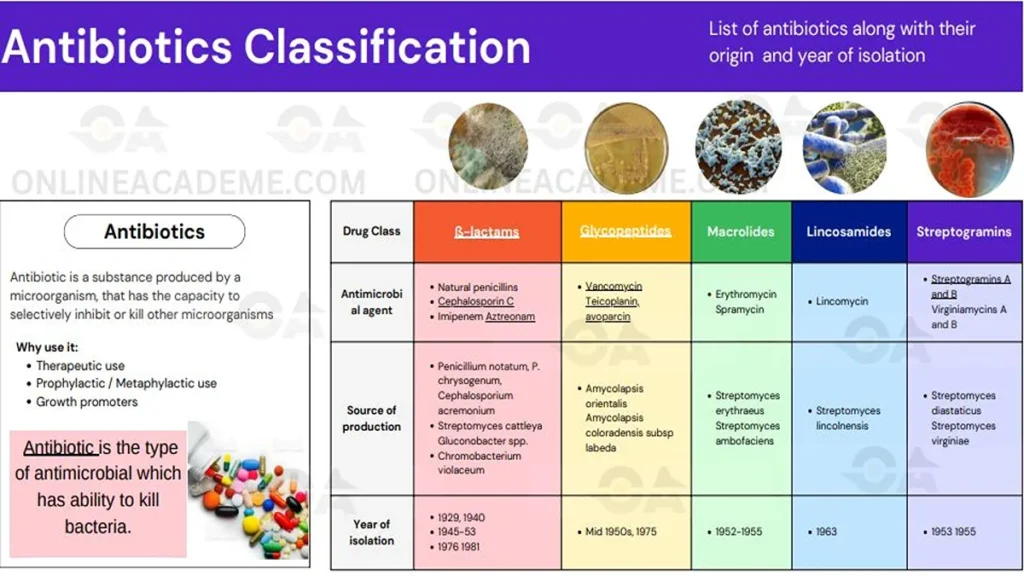
| Antibiotics List or Classification | |||
| Class | Antimicrobial agents | Producing organisms | Year of isolation |
| ß-lactams | Natural penicillins | Penicillium notatum, P. chrysogenum, Cephalosporium acremonium | 1929, 1940 |
| Cephalosporin C | Streptomyces cattleya Gluconobacter spp. | 1945-53 | |
| Imipenem Aztreonam | Chromobacterium violaceum | 1976 1981 | |
| Glycopeptides | Vancomycin Teicoplanin, avoparcin | Amycolapsis orientalis Amycolapsis coloradensis subsp labeda | Mid[1]1950s, 1975 |
| Macrolides | Erythromycin Spramycin | Streptomyces erythraeus Streptomyces ambofaciens | 1952-1955 |
| Lincosamides | Lincomycin | Streptomyces lincolnensis | 1963 |
| Streptogramins | Streptogramins A and B Virginiamycins A and B | Streptomyces diastaticus Streptomyces virginiae | 1953 1955 |
| Tetracyclines | Chlortetracycline Oxytetracycline | Streptomyces aureofaciens Streptomyces rimosus | 1948 |
| Phenicols | Chloramphenicol | Streptomyces venezuelae | 1947 |
| Aminoglycoside | Streptomycin Neomycin Kanamycin Gentamicin Tobramycin | Streptomyces griseus Streptomyces fradiae Streptomyces kanamyceticus Micromonospora purpurea Streptomyces tenebrarius | 1943,1949,1957,1963,1967 |
| Aminocyclitols | Spectinomycin | Streptomyces spectabilis | 1961 |
| Pleuromutilins | Tiamulin | Pleurotus spp | |
| Polypeptide antibiotic | Polymyxin B Polymyxin E (colistin) Bacitracin | Bacillus polymyxa (aerosporus) Bacillus polymyxa subsp colistinus Bacillus licheniformis | 1947 1949 1943 |
| Sulfonamides | Prontosil, sulfametoxazole, etc. | Synthetic | 1935 |
| Trimethroprim | Trimethroprim | Synthetic | 1956 |
| Quinolones | Nalidixic acid | Synthetic | 1962 |
| Fluoroquinolones | Ciprofloxacin, Levofloxacin, etc. | Synthetic | 1973 |
| Oxazolidones | Linezolid | Synthetic | 1987,1996 |
| Synthetic | |||
| Synthetic |
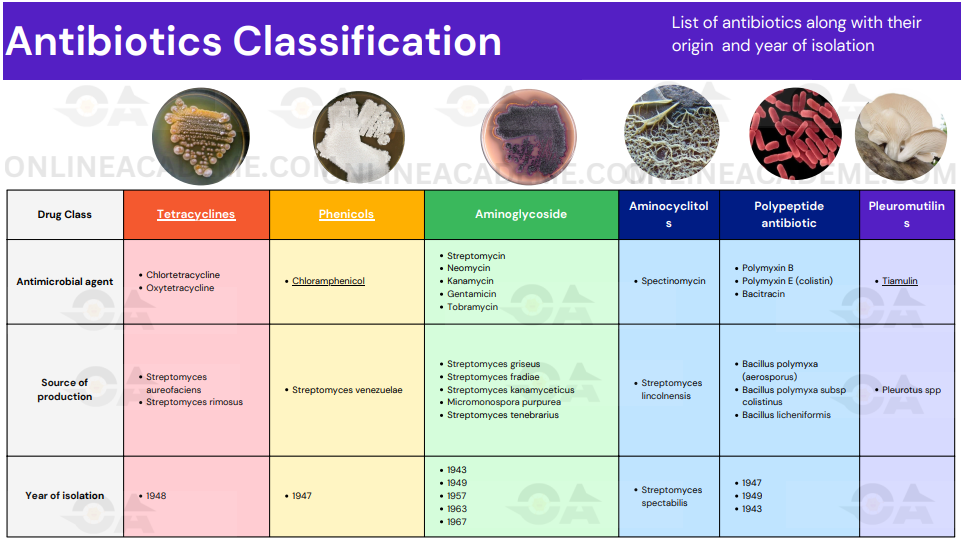
Bactericidal vs bacteriostatic drugs
Bactericidal drugs are recommended in life threatening infections where the immune system is unable to remove bacteria (e.g. endocarditis) and in immuno-compromised patients.Some drugs may be bactericidal or bacteriostatic depending on drug concentration, presence of other drugs, bacterial species.
| Class | Origin | Activity |
| Aminoglycosides | Streptomyces, Micromonospora spp. | Bactericidal |
| Cephalosporins | Cephalosporium spp. | Bactericidal |
| Macrolides | Various Actinomycetes | Bacteriostatic |
| Penicillins | Penicillium sp | Bactericidal |
| Phenicols | Streptomyces venezuelae | Bacteriostatic |
| Quinolones | Synthetic | Bactericidal |
| Rifamycins | Amycolapsis mediterranei | Bactericidal |
| Sulfonamides | Synthetic | Bacteriostatic |
| Tetracyclines | Streptomyces spp. | Bacteriostatic |
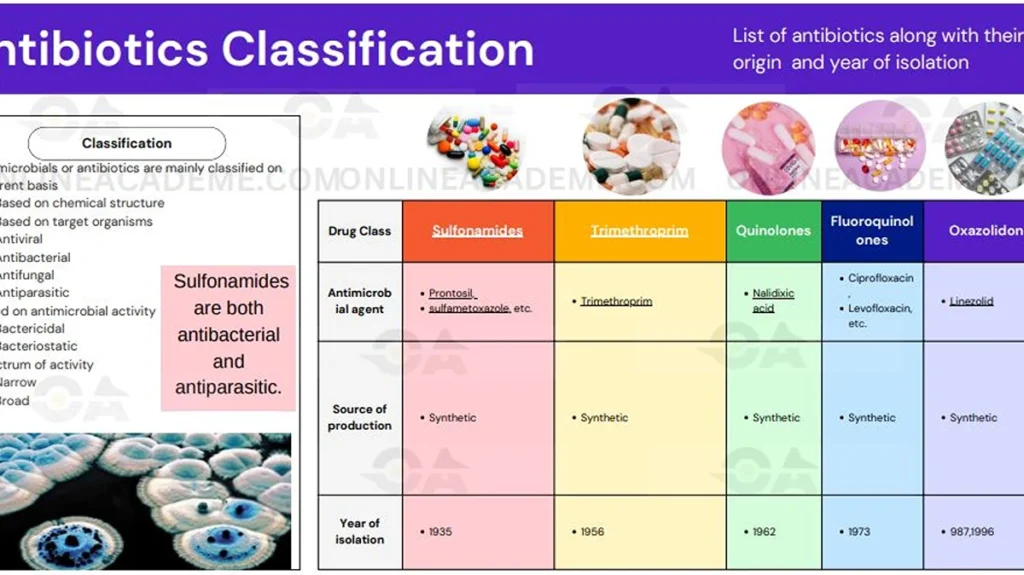
Antimicrobial effect vs PK/PD parameters
Pharmacodynamics (PD)
- Mechanisms for killing or inhibiting growth
- Time-dependent/concentration-dependent
- MIC – Minimum inhibitory concentration
- MBC – Minimum bactericidal concentration
Pharmacokinetics (PK)
Depend on route of administration, formulation, drug absorption, distribution, elimination, bioavailability
- Cmax (mg/mL) – maximal concentration in plasma
- Tmax (h) – time at Cmax
- t1/2 (h) – half-life • AUC LOQ (mg.h/mL) area under curve
Determine MIC and MBC of bacteriostatic drugs
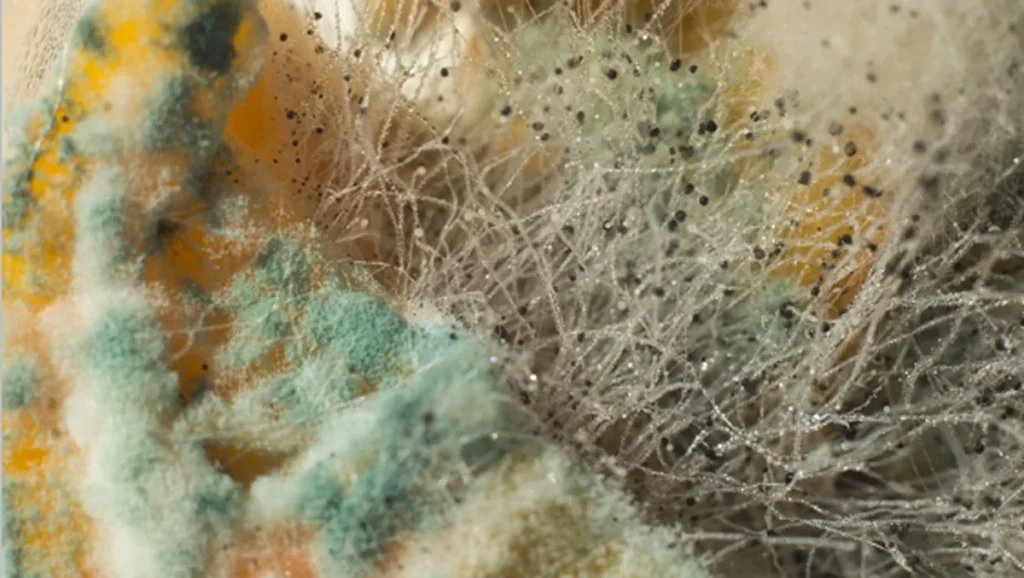
Use of associations of antimicrobials
- Increase efficacy
- Increase spectrum
- Synergic effect
- Not always beneficial, some combinations might be reducing efficacy: – E.g. bactericidal drug need microbial growth to act
- Antagonism (Bacteriostatic drug stop growth)
